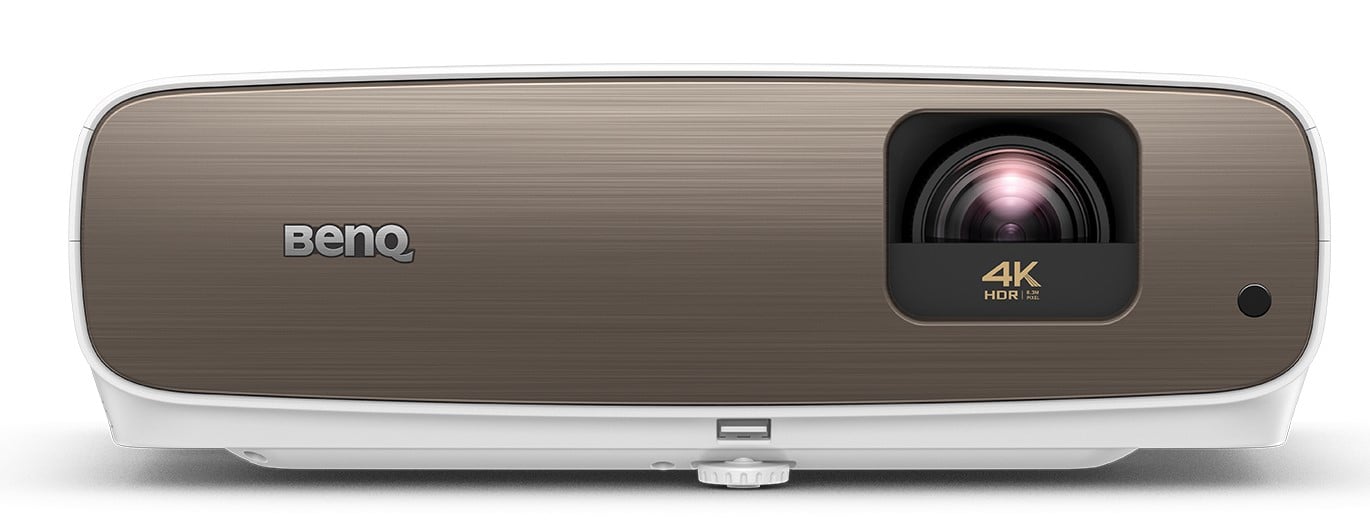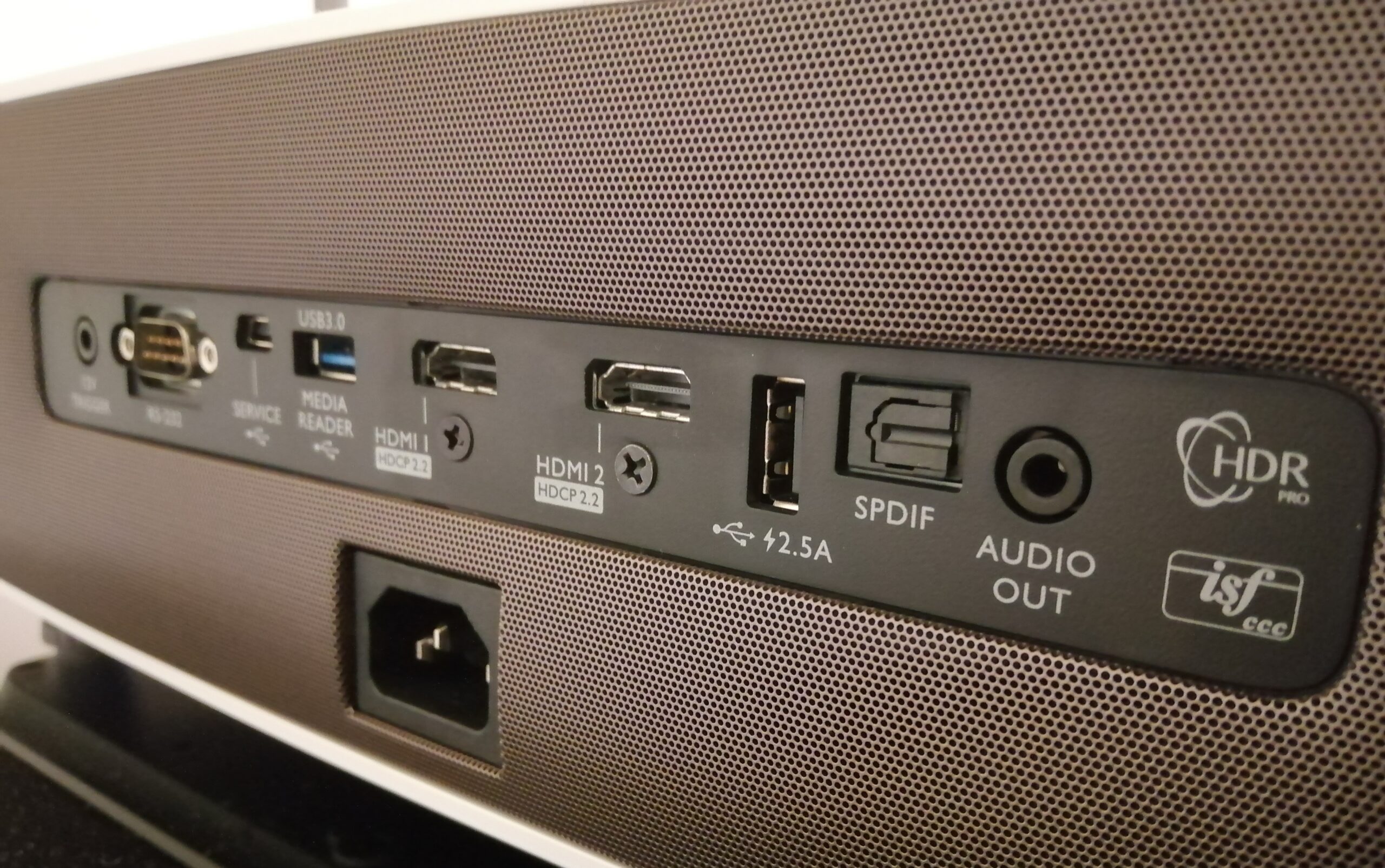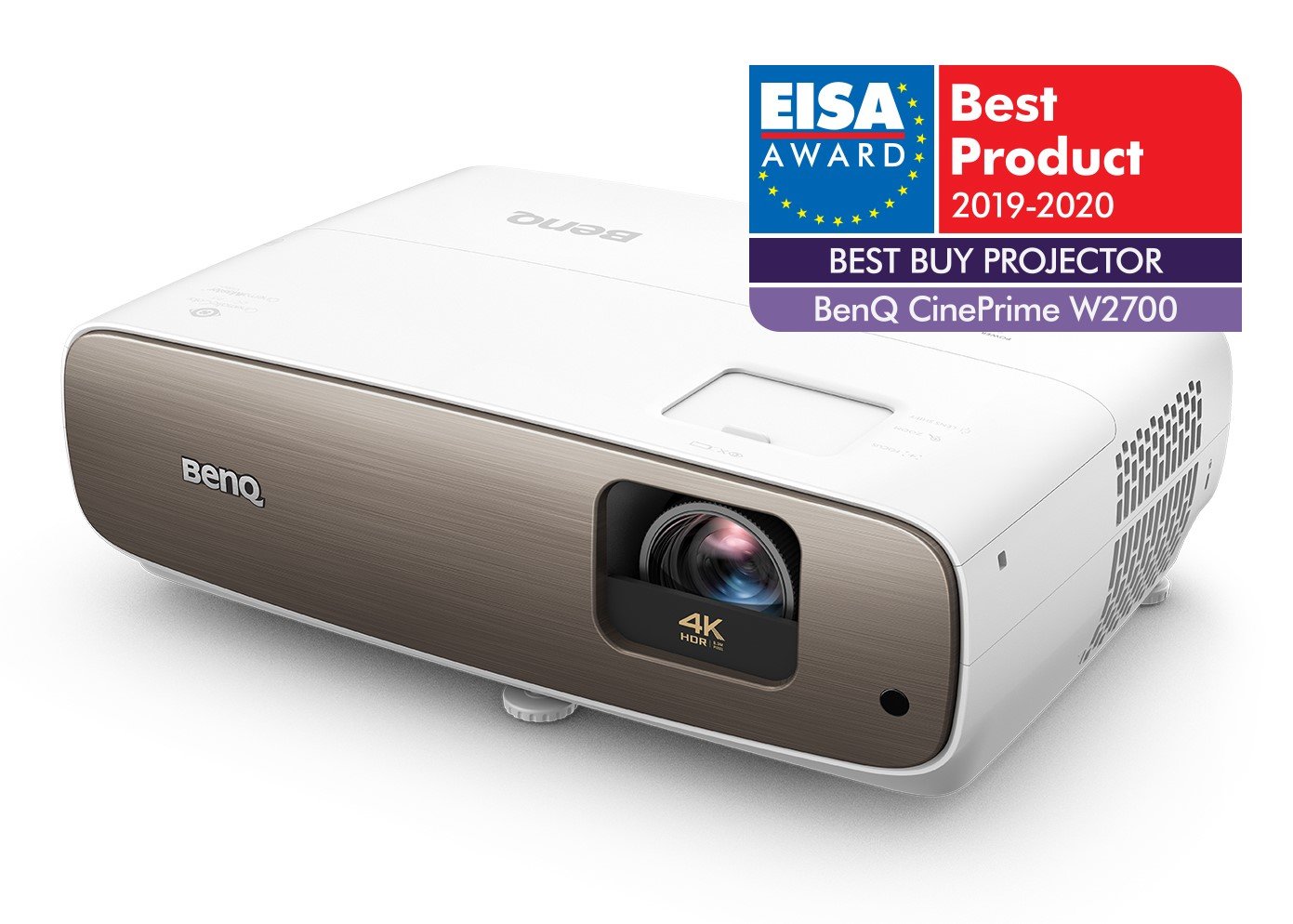BenQ HT3550
The BenQ HT3550 is a 4K home theater projector with HDR support that achieves excellent picture quality for the low $1500 price. Though not perfect due to weaker blacks and fan noise, it sets a new value standard thanks to its color gamut, resolution, and brightness.
WE LIKE
WE DON'T LIKE
- Sharp 4K resolution via pixel shift
- 95% of DCI-P3 color gamut
- HDR10 and HLG support
- Weak black levels
- Noisy fan in Normal mode
- Can't defeat keystone distortion
WE LIKE
- Sharp 4K resolution via pixel shift
- 95% of DCI-P3 color gamut
- HDR10 and HLG support
WE DON'T LIKE
- Weak black levels
- Noisy fan in Normal mode
- Can't defeat keystone distortion
It’s time for the BenQ HT3550. It’s extraordinary to think that while home theater audio made such substantial strides during the 1990s, image technologies appeared to lag so far behind. Even though the introduction of DVD upped the ante, it wasn’t until HD DVD and Blu-ray players entered the marketplace in 2006 that consumers could really get pictures at home that would rival the quality of their audio systems. We now live in a world where the arrival of 4K UHD and HDR technologies for home cinema have catapulted flat-panel and projected images into a new era, and certainly towards experiences that no one could have anticipated just 15 years ago.
No strangers to this new paradigm is one of the market-leading projector manufacturers, BenQ, who have created a splash in recent years by introducing a string of affordable, compact-footprint 4K beamers, starting with the top-selling W1070 in 2013, and followed by the TK800 and HT2550. We now have the CinePrime HT3550 (W2700 in Europe and Asia), which the company wisely promotes as a projector designed for viewing in a light-controlled environment. It not only boasts HDR10 playback, but also 95% of the professional DCI-P3 color space and a dynamic iris, the last two features of which are previously unheard of at this affordable $1,500 price point.

Design and Features
The BenQ HT3550 employs a 0.47-inch 1920 x 1080 DLP XPR single chip plus 6-segment (RGBRGB) color wheel, and renders 8.3 million individual pixels on screen by pixel-shifting four times per frame (96Hz). In addition to HDR10 for 4K UHD Blu-ray playback, the projector includes the HLG broadcast and streaming HDR standard, both of which are automatically detected by the projector which, in turn, triggers a dedicated HDR10 picture mode from the previously selected D. Cinema position. Additionally, for the switch to D. Cinema (standing for ‘dark’, not ‘digital’) or HDR10 modes, a filter is slotted into the light path to realize either 100% of REC.709 or the wider color gamut capability of up to 95% of DCI-P3, which you’ll hear audibly as a ‘click’.
Other picture mode choices include Bright, Vivid TV, Cinema and User, the latter of which can borrow from any of the existing modes as a template for your own settings/calibration. 3D users will be pleased that a dedicated 1080p mode for such content is also provided, and there are unlockable ISF Night and Day modes. Perhaps not surprisingly, keen gamers should probably consider other models, as input lag reportedly measures north of 60ms.
The manufacturer claims a light output of 2,000 ANSI lumens and a 30,000:1 contrast ratio. A 1.13 – 1.47 generous throw ratio means you can achieve a 100-inch diagonal 16:9 image from a distance of just over 8 feet. Placement flexibility is enhanced by a 10% (+/-5%) vertical lens shift facility, allowing ceiling mounting slightly above the screen top border or lower table placement slightly below the screen bottom border.
However, even with the 1.3x zoom deployed here, it should be noted that if you’re a fan of constant height (CIH) projection for Cinemascope images, you won’t have enough image size play or lens shift to map out a 2.39:1 picture, but that restriction is typical of this category and price range of device. There is an option to correct keystone electronically if the placement is not perpendicular (or you’re using the adjustable feet for angling up towards a screen), but I would advise against using this feature as it will degrade uniform image quality.
BenQ has excelled itself applying aesthetically pleasing designs to its latest range of DLP projectors. The BenQ HT3550 is housed in a curved and textured matte white body with front copper-tinted faux brushed aluminum fascia. Its sleek but unobtrusive design will complement any living or media room and its low-profile 38 cm width and 26 cm depth, plus 9.2lbs (4.2kg) weight, mean the unit is highly transportable and easy to set up. A welcome damper plate has been fixed to the lens opening on the front to prevent ceiling or table-top light spillage, an improvement over the HT2550.

Rear panel connections are amply catered for with 2 x HDMI 2.0, 2 x USB Type A (one allocated for media readers and firmware updates), USB Type Mini B (service port), 2 x Audio Outs (mini jack and S/PDIF), RS232 In, 12V Trigger (3.5mm) and IR receiver. The white remote control is a pleasing backlit design with logical key placement, and the projector includes 2 x 5W speakers if you decide not to combine with a dedicated sound system. These perform surprisingly well on all program material and are useful if you’re planning an outdoor movie night or impromptu indoor setup.
In Use and Performance
For my evaluation, I used a 90-inch 1.1 gain fixed frame screen with shelf-placed front projection and no lens shift. While both the noticeably green-biased Bright mode and sports-suited Vivid TV mode are intended for well-lit and ambient light conditions respectively, the most appealing out-of-box settings were those for the Cinema and D. Cinema modes. BenQ recommends the first of these for SDR material with a small amount of ambient light, while D. Cinema is primed for 100% of the REC.709 color space in a darkened environment. The automatically-triggered HDR10 mode with wide color gamut (WCG) and 95% of DCI-P3 selection provided the settings for 4K UHD Blu-ray viewing.
With the Brilliant Color setting defaulted to zero and automatic iris at the (surprisingly quiet) High selection, HDR images from 4K UHD discs were exemplary for a projector in this price/performance category. Lionsgate’s Hereditary 4K UHD disc constantly throws out ample testing fodder for an HDR projector with bright oranges and yellows frequently set against dark grays, grades of shadow and blacks. When a single candle is the only light source in a séance room or a pair of car headlamps illuminate a night-time porch, there is hardly a trace of unwanted clipping or competition with the intentionally drab, yet layered surroundings. Importantly, BenQ’s HDR-PRO technology and tone-mapping ensure that HDR material appears comparatively bright, so the projector does not suffer from the inherent ‘dark picture’ problems that were associated with some early-generation HDR projectors.
When it comes to the pixel-shifted 4K resolution, you will also be hard-pushed to differentiate the exceptionally detailed image here to the performance of a native 4K chip, unless you were to test them side-by-side. Even on close inspection of the screen, it is virtually impossible to discern individual pixels. The mission control room in Apollo 13 (4K UHD) is littered with panel dials, switches and TV monitors, all of which are sharp and clearly identifiable, while facial closeups of Hanks and his fellow astronauts are translated to the screen with every pore and imperfection on display for all.
The projector does an admirable job on SDR 1080p material too, viewed interchangeably in both Cinema and D. Cinema modes. The Gravity Blu-ray exhibited a magnificently detailed starfield and all the intricate mechanics of both the exteriors and interiors of the international space station. As is typical of DLP projectors, the HT3550 also handled fast motion with aplomb and the unit sails through the complex space shuttle destruction scenes near the start. Viewing Universal’s beautifully-mastered Jaws Blu-ray is like looking through a window, and the BenQ retains all the title’s subtle film-originated grain and suitably lifelike skin tones.
While the HT3550 is capable of truly impressive pictures, as well as competent contrast, what you might be less inclined to write home about is the black level itself, which rarely musters more than a dark grey, and is noticeable with top-and-bottom black bars displayed as soon as you spin up a 2.4:1 disc. Consequently, the projector tends to lack the image depth of more pricey competitors. You should also be aware that the fan is quite noisy in Normal (highest) lamp mode, rather than Eco, but you might feel you need to keep it in this setting for HDR content, particularly if your screen is pushing 110 – 120 inches diagonal.
Although it has never been a deal-breaker for me, I do suffer partially from rainbow effect (RBE) and was aware that when my eyes inadvertently darted around the screen or tracked fast movement, I would occasionally see the annoying RGB lines appear and disappear rapidly in the corners of the screen. However, if you’re one of those people who does suffer particularly badly from RBE, this should be a factor in your buying decision with any single-chip DLP projector.
Conclusion
The BenQ HT3550 produces a gorgeously cinematic image for the price and whether you’re scoping out a second projector for summertime rooftop movie shows or need a budget beamer for a permanent installation (albeit with restricted placement), this recent addition to the BenQ range can happily satisfy both requirements. You won’t enjoy the black levels of the sub-$3k UB Epsons or even those of the HT3550’s larger HT5550 sibling. But the idea that you can now have 4K UHD resolution, and almost the full DCI-P3 professional digital cinema color space paired with a robust automatic iris – all for under $1,500 – is simply unheard of so far in the evolution of home cinema projectors. Those features alone, combined with the projector’s exceptional performance, mean that the BenQ HT3550 looks like being nothing short of a new price/performance industry benchmark.
Rating 4.5/5
Martin, a seasoned journalist and AV expert, has written for several notable print magazines. He’s served in key roles at Lucasfilm’s THX Division, NEC’s digital cinema division, and has even consulted for DreamWorks. Despite his illustrious career, Martin remains rooted in his passion for cinema and acting, with notable appearances in several Spielberg films, Doctor Who, and Star Wars: The Empire Strikes Back. He currently resides in San Francisco.
Post Disclaimer
Some of our content may contain marketing links, which means we will receive a commission for purchases made via those links. In our editorial content, these affiliate links appear automatically, and our editorial teams are not influenced by our affiliate partnerships. We work with several providers (currently Skimlinks and Amazon) to manage our affiliate relationships. You can find out more about their services by visiting their sites.






Similar threads
- Robert Harris
- Blu-ray and UHD
2 3- Robert Harris
- Blu-ray and UHD
3 4 5- Robert Harris
- Blu-ray and UHD
6 7 8